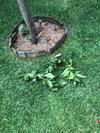Dear Reader, in this age of AI created content, please support with your goodwill someone who works harder to provide the human-made. Sign up in the righthand column or bottom of this page. You will receive my hand illustrated monthly newsletter RESTORE NATURE and access to the biodiversity garden design course as I write...and nothing else, I respect your time.
South Africa's wild plum tree, Harpephyllum caffrum
easy to grow and very drought hardy
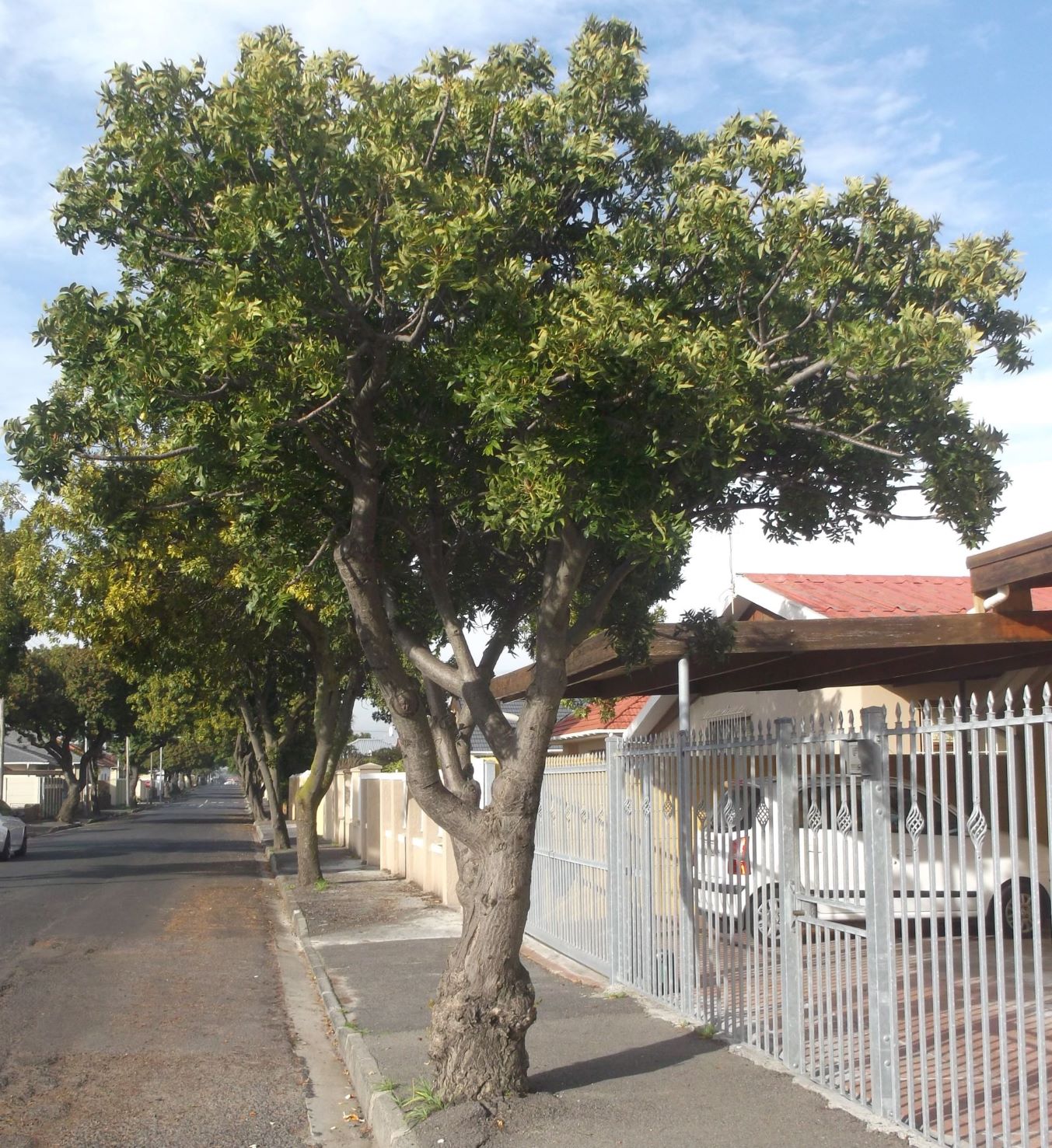 A wild plum tree as a street tree.
A wild plum tree as a street tree.The wild plum tree of South Africa
makes a very attractive street or garden tree, with its dense green
foliage and bright red edible berries in season. They grow wild in
riverine forest from the Eastern Cape all the way up to Zimbabwe.
Thus my first encounter with the tree was as a child in our garden in
Port Elizabeth. We loved climbing up into the twisted gnarled old
tree to harvest fresh berries, and the taste stayed with me. It is
extremely sour, a little milky, something like green mango, a little
tarry, but has a taste of its own that is indescribable. I was
delighted to find it planted as a street tree where I live in
Goodwood, in Cape Town. It is also one of the most potent anti-oxidant foods in the world (see link at page bottom). This research article shows the anti-oxidant potency of local berries,
and I cite them here from the top down, according to their rating on the anti-oxidant potency composite index: wild plum (225), colpoon (174), wild olive (173), then the trendy western blueberry (146). Following are the christmas berry (106), cross berry (74), waterberry (44) till we finally get to another trendy exotic the cranberry with 38 ! Below that is the tortiose berry (37), bietou (32), num num (27) and humble sour fig (21).
The wild plum tree seems not to be prone to disease. It is also drought hardy, which is probably the reason for it being used in street plantings. In paved areas it tends to be smaller, but it can grow up to 15 meters under the right conditions. Its roots lift the tar on the pavement (sidewalk) about 1 meter around the thick stems of old trees, and give rise to a lot of maintenance work by the city. It should ideally be planted in an unpaved tree bed.
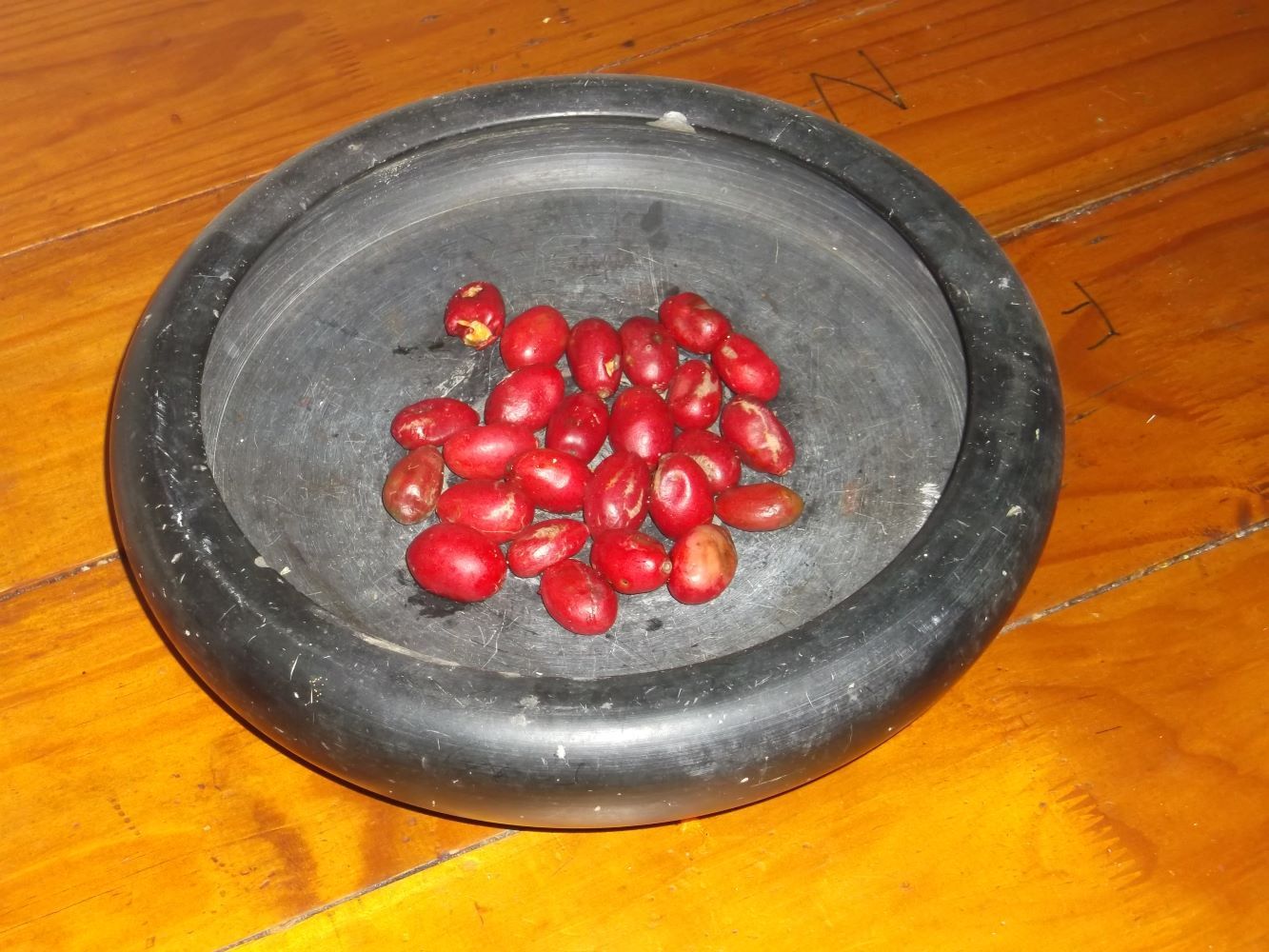 The fruit of the Umgwenyobomvu are incredibly red
The fruit of the Umgwenyobomvu are incredibly redThe wild plum tree is native to this country and it has many indigenous names, as the fruit were enjoyed for countless centuries before the Europeans came and gave the typical colourless colonial name in the pattern of “wild something-we-know-from-Europe”. There are many examples of this type of naming, even in the naming of animals.
Its indigenous name is Umgwenyabomvu in isiXhosa. Bomvu is an adjectival suffix meaning red, and Umgwenya translates as olive or obstacle. The term 'obstacle' may refer to magical or medicinal properties in traditional indigenous herbalism, as this is a pattern in the naming of medicinal plants, but I don't have clarity on that. Umgwenya is also its name in IsiZulu. In Sesotho sa Leboa it is Mothekele or Mmedibibi.
Its Latin name is Harpephyllum caffrum. Harpephyllum means sickle-leaf, and caffrum comes from Kaffraria, the old colonial name for the Eastern Cape.
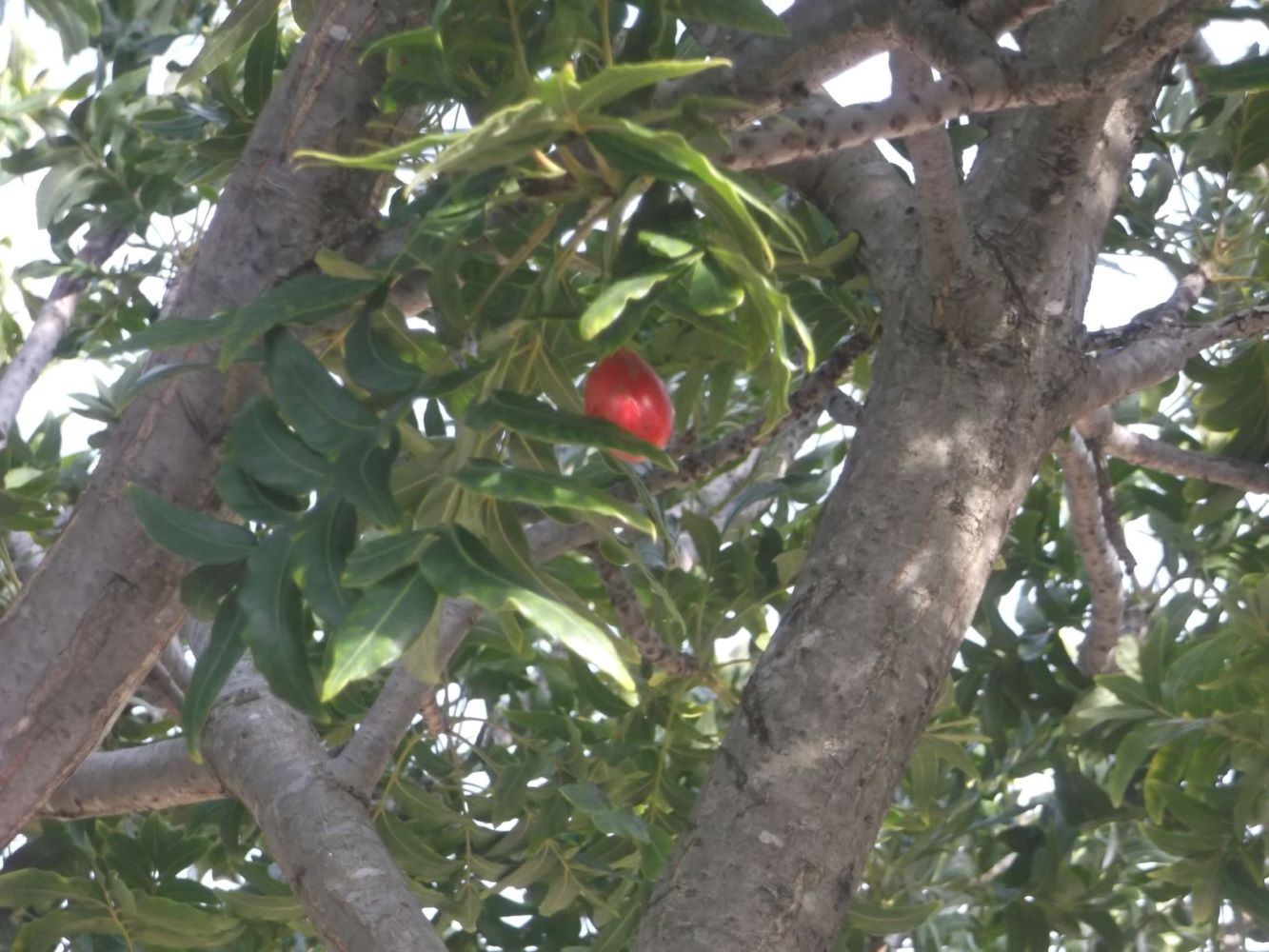 Sickle shaped leaf, red berries and pimply new bark
Sickle shaped leaf, red berries and pimply new barkRemembering the sickle-leaf in the Latin name helps with identification, and differentiating it from Ekebergia capensis, to which it bears a striking resemblance. The sickle-leaves and the clustering of the leaves at the end of the branches, help to distinguish Harpephyllum, until it can be recognized instinctively.
Growing the wild plum tree of Southern Africa from seed
The seed is large and hard, and the fruit itself merely a thin skin, 2-3 mm thick, over the seed. Some would call it unrewarding as a fruit, but I have found some use for it in ferments. No longer being given to climbing trees, I must perforce harvest the berries from the ground, where they are often dirty or desiccated. It would be really nice to have one in the garden, which I could train for easy harvesting in a clean state. This led me to cultivating the tree myself.
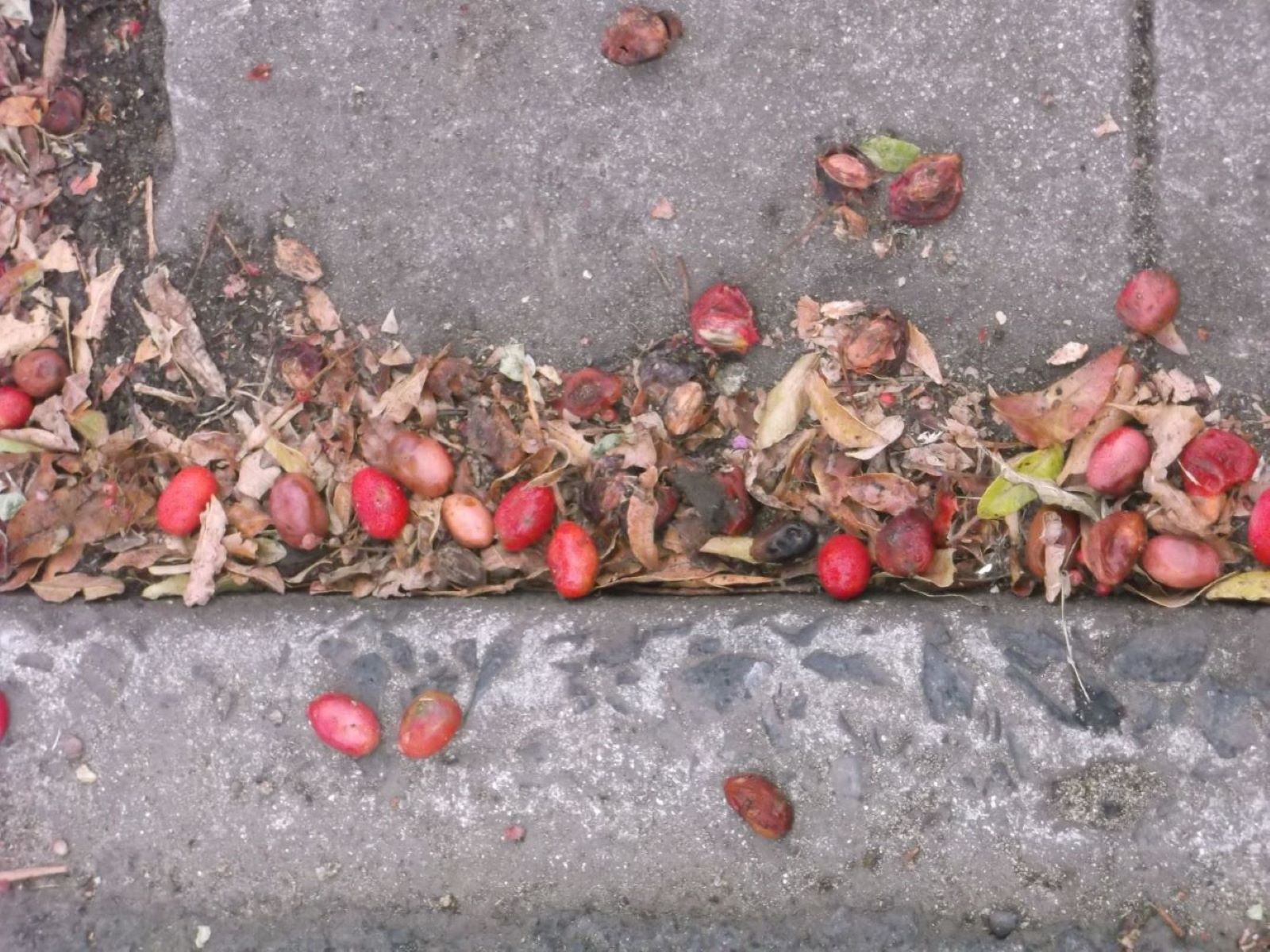 Harpephyllum caffrum fruit and seeds collect in the gutters.
Harpephyllum caffrum fruit and seeds collect in the gutters.To obtain the fruit, I swept up many of them where they had fallen on the street. These were washed numerous times, and then sorted, and the bad ones set aside. The rest were fermented with a little vinegar and sugar in water, to sanitize them. After the wine was poured off, the fruit were stripped of the seeds and these seeds, with the rotten fruit I'd set aside, were planted.
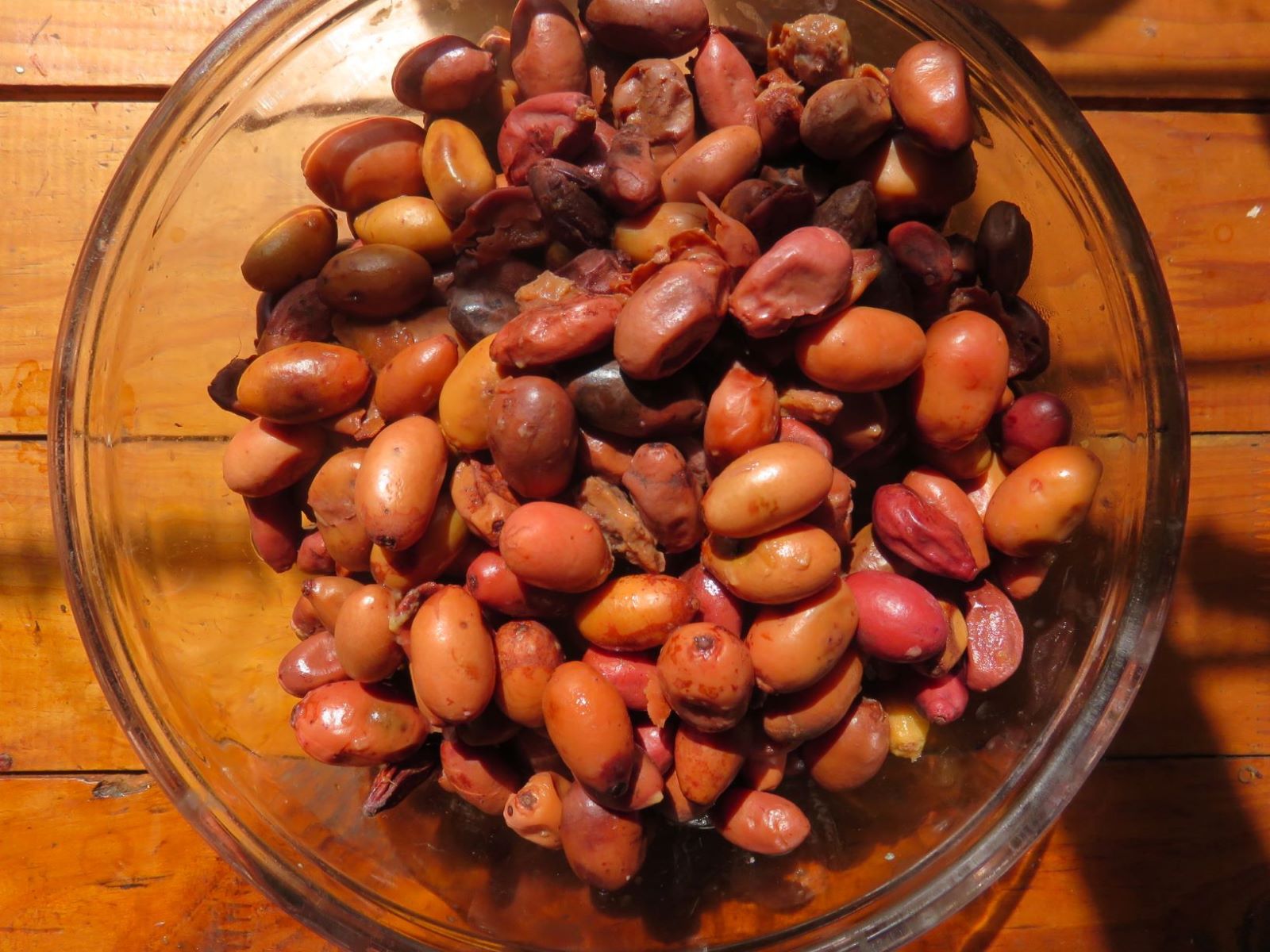 The fruit after fermentation and sorting. Unfortunately that beautiful red is transitory,and destroyed by oxidation and fermentation.
The fruit after fermentation and sorting. Unfortunately that beautiful red is transitory,and destroyed by oxidation and fermentation.The wild plum tree or Umgwenya is not native to the winter rainfall area of the Cape, but to the lush summer rainfall areas in the east. Perhaps this was the reason it germinated very well in the nursery. After a long wait, taking between 119 and 143 days in spring between August and December, it showed its first glossy sprouts.
Some seeds planted in flats in late September never came up. They would have missed the first few weeks of consistent rain received by the others. Perhaps the seeds should be soaked and roughly cleaned before planting. The successful lot had rain, and they had been fermented in water and were planted with scraps of fermented flesh on them, the second lot were dried, with the flesh on them, if I remember correctly. Many local tree seeds have germination retarders in the flesh of their fruit.
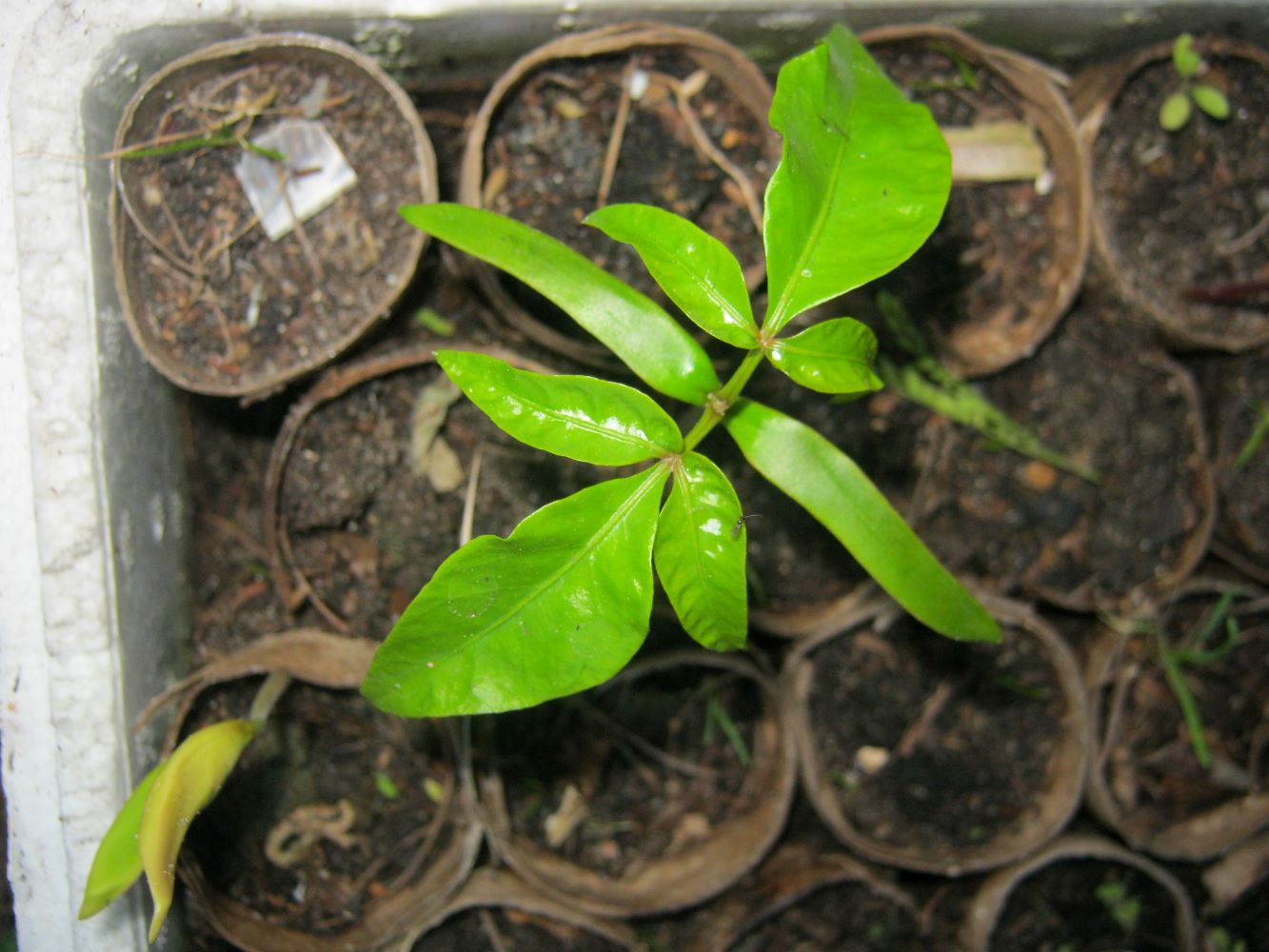 The first seedling emerging from the cardboard tubes.
The first seedling emerging from the cardboard tubes.After such a long wait there was much joy when the first sprouts emerged from the cardboard tubes (toilet roll cores) in which they were planted. My seed mix is usually 3 parts sand to 1 part vermicompost. Worm compost has a special microbiome that protects seedlings from fungal infection, and provides some nutrients, but not enough for long term growth.
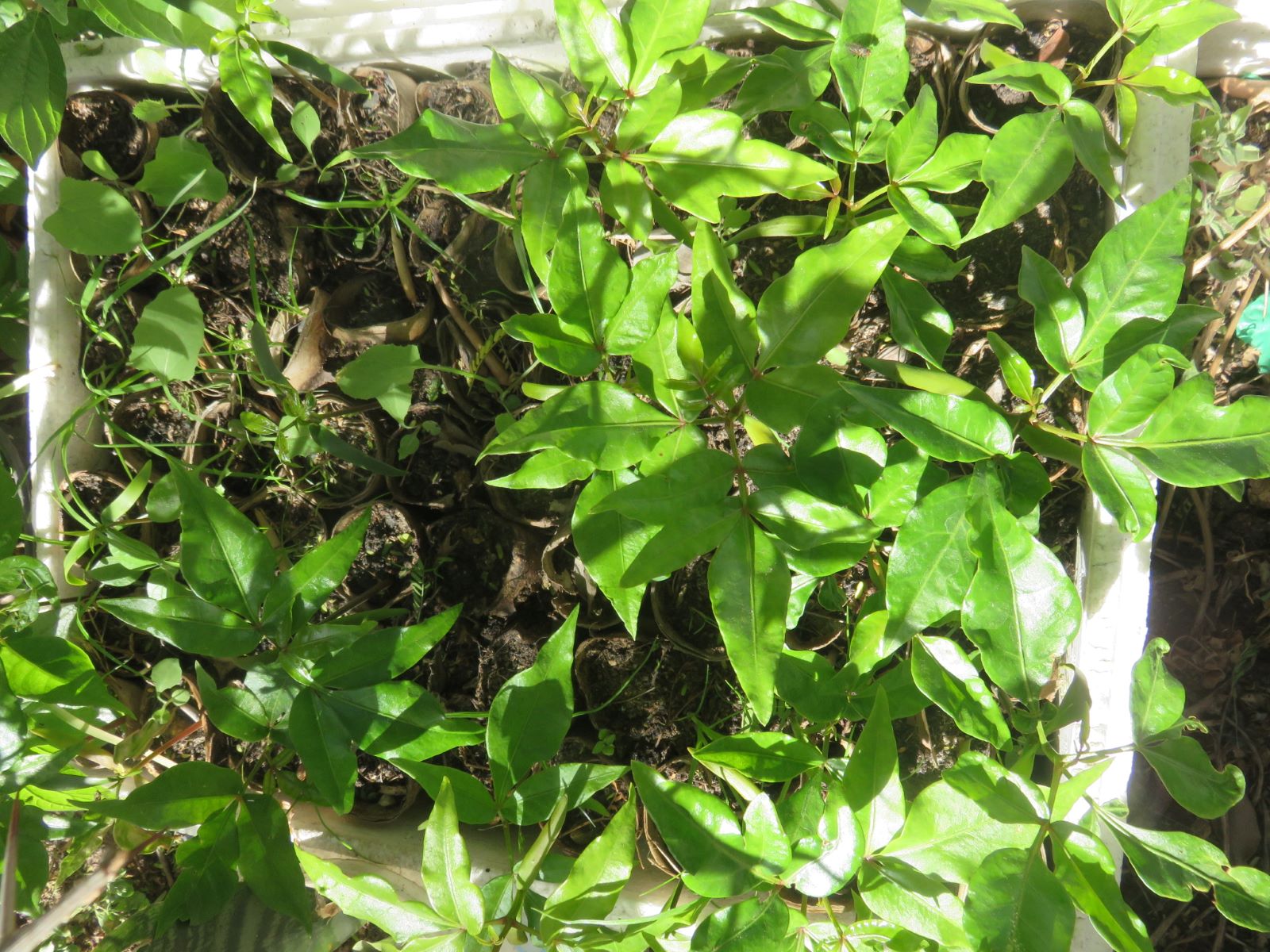 The wild plum germinated pretty well, and are ready to transplant.
The wild plum germinated pretty well, and are ready to transplant.When the seedlings had about six leaves they were transferred to recycled planting bags (plastic milk sachets) with more compost in the potting mix. They are still there after a year, as I lost interest in my tree nursery which I had hoped would bring me some profits. Having regained my motivation by starting a perennial food plant collection that holds many native plants, I'm so happy for their hardiness. They have stayed alive and remarkably healthy looking, despite growing larger in those tiny bags. Judging from their undemanding nature with confined root space, they may just make a good potted plant. I hope when I plant them out that the process will have dwarfed them a little as we have a small garden.The more stunted trees in our street also seem to bear more heavily.
It is a dioecious plant so you will need a few specimens to ensure you have male and female trees. The tree is amenble to pruning.
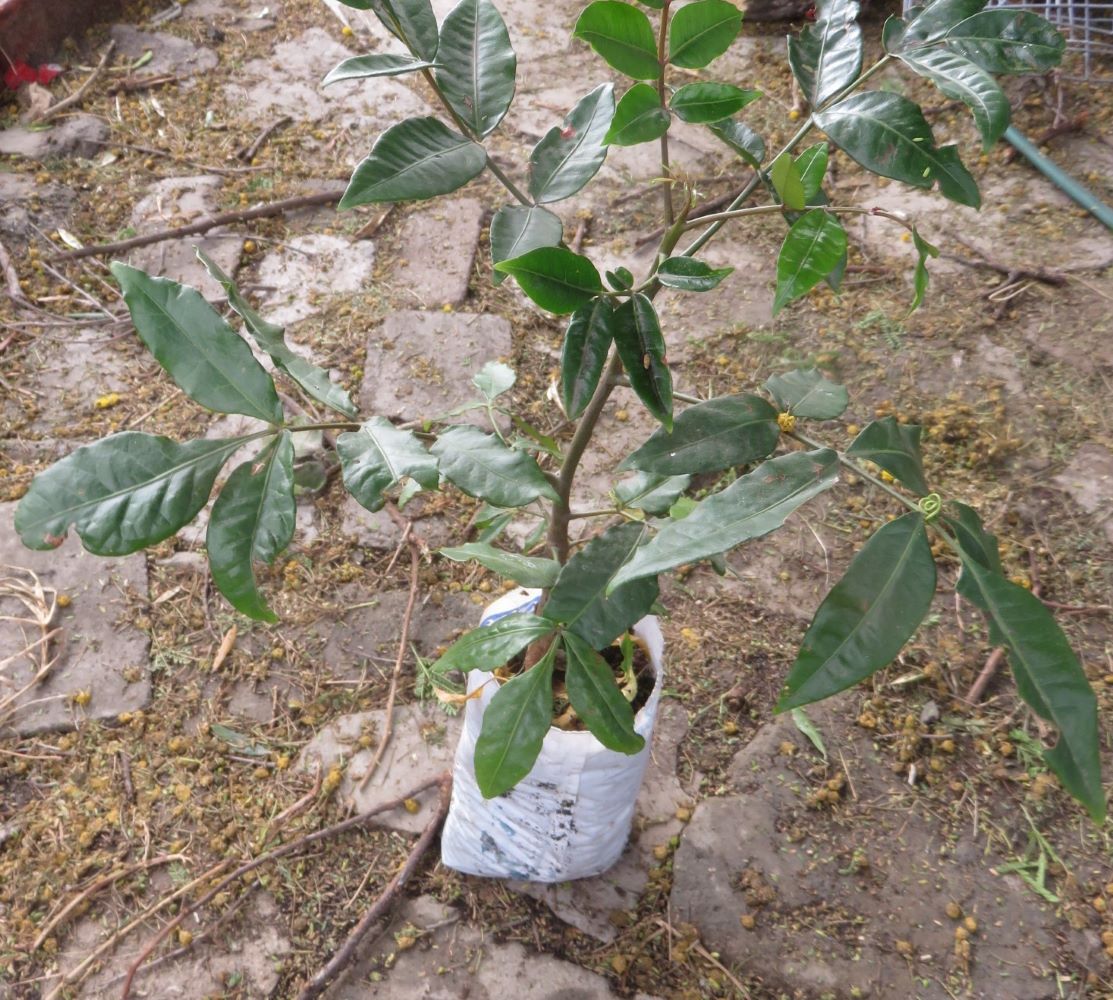 This wild plum tree sapling is about 18 months old.
This wild plum tree sapling is about 18 months old.In another article on our food website I will give a recipe for Harpephyllum vinegar. Home brewed vinegar is one of my remedies for boosting gut flora diversity. Natural vinegar contains a lot of lactobacteria, without having the milk contents to which many people are allergic.
The wild plum's acidity and tannins are evident, and both bode well for natural preservation of the ferment. Some people even make pink wine from the berries. The fruit are pretty sour and sugar must be added to boost fermentation. The first fermentation produces a very fine aroma, but the vinegar can be prone to oxidation. Then it turns pale brown and tastes flat. Oxidized vinegar can harbour pathogenic organisms and should ideally not be consumed.
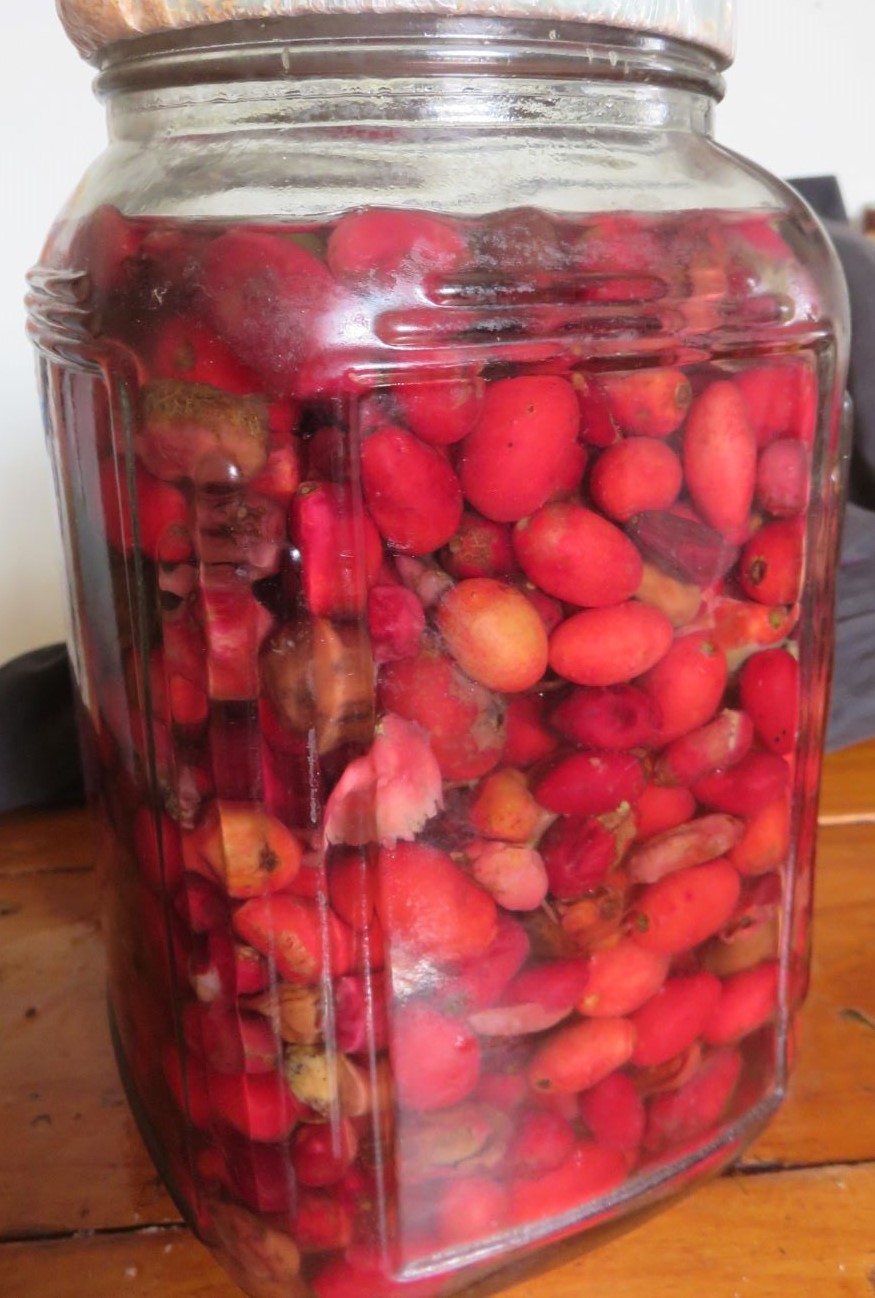 A wild ferment made with Harpephyllum caffrum was delicious.
A wild ferment made with Harpephyllum caffrum was delicious.------
home page for many useful links on natural gardening
------
perennial food plants for a work-less food garden
------
South African berries contain potent anti-oxidants
Restore Nature Newsletter
I've been writing for four years now and I would love to hear from you
Please let me know if you have any questions, comments or stories to share on gardening, permaculture, regenerative agriculture, food forests, natural gardening, do nothing gardening, observations about pests and diseases, foraging, dealing with and using weeds constructively, composting and going offgrid.
What Other Visitors Have Said
Click below to see contributions from other visitors to this page...
The 3 Wild Plums. 




I have 3 Wild Plums in my garden. I moved in 25 years ago and they were here already. Now I have trouble with my neighbors because the garden wall is …
The 3 Wild Plums. 




I have 3 Wild Plums in my garden. I moved in 25 years ago and they were here already. Now I have trouble with my neighbors because the garden wall is …
Lynette 




can an established, large, wild plum tree Harpephyllum caffrum be pruned in order to try shape/reduce the width of its canopy? I have a huge wild plum …
plum tree 




Can I transplant a young wild plumtree anytime or ? It is now 2m tall.
Great article. 




I love the beautiful structure of the wild plum. Propagating from seed, lots of success. I clean and leave to dry, sand both sides and on one side for …
Help needed 




Hi there, we have a Wild Plum tree it's about 7 years old and during winter it was doing well nice colour and tree was full. When we went into Spring we …
Jane 




Hi
Our wild plum tree of about 3m has grown new shoots & leaves on only 3 of about 7 branches & every day we find the new little branches of about 30cm …
SEARCH
Order the Kindle E-book for the SPECIAL PRICE of only
Prices valid till 30.09.2023
Recent Articles
-
Geography Research Task
Jan 31, 25 11:37 PM
To whom it may concern My name is Tanyaradzwa Madziwa and I am a matric student at Springfield Convent School. As part of our geography syllabus for this -
Eco Long Drop Pit Latrines Uganda
Nov 29, 24 02:45 AM
Good evening from the UK. My name is Murray Kirkham and I am the chairman of the International and foundation committee of my local Lindum Lincoln Rotary -
Landscape Architect
Oct 01, 24 10:42 AM
I so appreciate your informative description! Your experimentation and curiosity with the seeds, germination, and rearing of the maggot are exciting to
"How to start a profitable worm business on a shoestring budget
Order a printed copy from "Amazon" at the SPECIAL PRICE of only
or a digital version from the "Kindle" store at the SPECIAL PRICE of only
Prices valid till 30.09.2023
